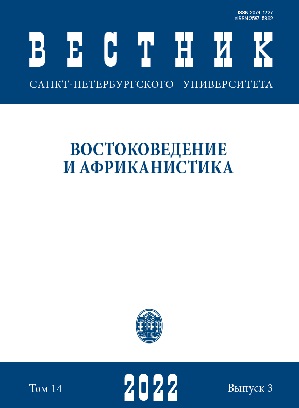The Hidden Meanings and Poetic Features of the Treatise “Činggis-un yisün örlüg-tei öničin köbegün-ü čečelegsen šastir”
DOI:
https://doi.org/10.21638/spbu13.2022.307Abstract
The extant variants of the now-lost treatise Činggis-un yisün örlüg-tei önöčin köbegün-ü čečelegsen šastir are attested in the 17th-18th century Mongolian historical chronicles Altan Tobči / The Golden Chronicle (1655) by Lubsangdanjin and the Bolor Erike / “Crystal Rosary” / (1774-1775) by Rasipungsug. This article addresses the history of transmission, translations, and studies of this text, and demonstrates that the Činggis-un yisün örlüg-tei öničin köbegün-ü čečelegsen šastir is not merely an account of Chinggis Khan’s discussion with his nine high officials about the benefits and evils of alcohol, but contains deeper hidden meanings. Specifically, this paper offers the following four findings: First, based on comparison with Mongolian historical sources, this paper clarifies the origins of Chinggis Khan’s nine high officials, how they befriended Chinggis Khan, their merits and accomplishments, and their deaths. Based on these sources, we have determined that the events described in the Činggis-un yisün örlüg-tei öničin köbegün-ü čečelegsen šastir date to 1206-1207. Second, this paper discusses the hidden meaning that Bo’orchu, Muqali, Boqorul, Jebe, who wish to abstain from alcohol and diligently perform their duties, befriended Chinggis Khan in their childhood without seeking any benefit, were fully trustworthy officials, whereas Sorqan-Shira, Jelme, Yelü Chucai, Qara Kiru and Shigi-Qutuqu - who, in their own words, wish to drink alcohol and revel - befriended Chinggis Khan later out of self-benefit, and were untrustworthy officials. Third, the paper discusses the symbolism of the order of the speakers’ words on alcohol as it relates to the ranks of Chinggis Khan’s officials, as well as Mongolian cultural symbolism relating to directions. Fourth, based on the debate in the text between the orphan boy, wise nobleman Chindagha, and Chinggis Khan, this paper discusses the fact that one reason Chinggis Khan’s state was powerful is that he listened to average people and he was able to reflect their ideas in national affairs. Fifth, this paper demonstrates that the text retains important features of deep hidden meaning and poetic verse characteristic of 13th century Mongolian literature.
Keywords:
Lubsangdanjin, Altan Tobchi, Chinggis Khan, nine officials, Orphan Boy, Wise Nobleman Chindagha, hidden meaning, Mongolian poetry
Downloads
References
Downloads
Published
How to Cite
Issue
Section
License
Articles of "Vestnik of Saint Petersburg University. Asian and African Studies" are open access distributed under the terms of the License Agreement with Saint Petersburg State University, which permits to the authors unrestricted distribution and self-archiving free of charge.





